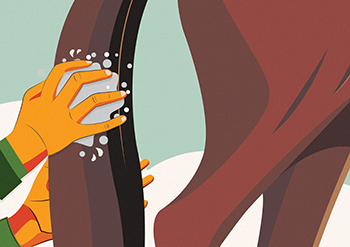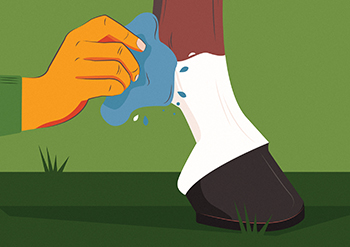
Six tips for getting your horse tip-top and ready to go
We asked owners for the tried-and-tested ways they get their horses looking their best before a show or competition. Here are the practical steps and clever tips they shared.

1. PERFECT PLAITS
‘The secret to great plaits is to start with a mane that’s short and scrupulously clean. I then work a penny-sized blob of hair gel through my horse’s mane, and separate a section of hair behind his poll with a mane comb, keeping the part next to it out of the way with a wooden clothes peg. Once I’ve plaited each section, I roll each one up and sew it in place using a blunt-ended needle with thread that matches my horse’s coat colour. I try to make sure the plaits are stitched securely and I aim to leave as little thread visible as possible. Lastly, I tuck or snip away any stray hairs and add some glistening oil to finish off. My best tip is to stand on a block so that you can lift the hair at the roots and plait ‘up’ rather than down. This makes the plaits stand neatly on the crest and will emphasise your horse’s topline.’
– Chloe Jones, amateur show rider


2. EYE-CATCHING QUARTER MARKS
‘First off, I dampen the hair on my horse’s hindquarters with a sponge before applying a dab of pomade to help define the marks and fix them in place. I prefer to work freehand to create the marks with a body brush or a marker comb, rather than using a stencil. To create rounder-looking quarters, I run the body brush down the centre of the marks on each quarter, and then in an arc from the dock down to the limb, and use a touch of glistening cream to highlight the finished pattern.
‘You can watch online video tutorials for pattern ideas, but I always advise riders to choose marks that are appropriate for the class their horse is competing in and the shape of his quarters. For example, curved shark’s teeth will compliment the quarters, but V-shapes that slope down towards the tail rather than staying straight can make the hind-end look weak. It can also help to stand on a block so that you can see both sides of your horse. Your marks will then start and finish in the same place, so his quarters look even.’
– Samantha Osborne, show producer
3. GLOSSY MANE AND TAIL
‘Show preparation always starts early for us, as my Gypsy Cob’s flowing white locks are quite high maintenance! To ensure his knee-length mane is in tip-top condition, I wash both his mane and tail once a week with baby shampoo before applying no-tangle conditioner or a hair serum from my own stash. His mane is then continually kept in a running plait, and he wears a Lycra vest or a cotton summer sheet with a hood to protect its roots.
‘The night before a show I run through his tail with a pin brush and bandage the full length of it. I’ve found that using chalk powder on his hair can pick up the colour from an arena surface, so I steer away from it and just make sure that his mane stays really clean and stain-free.’
- Lisa Bates, show rider


4. SPOTLESS SOCKS
‘To keep my Coloured Cob mare’s socks looking pristine, I regularly wash her legs with a stain-removing shampoo and use a magic brush. Her feathers are clipped off and we try to keep her legs as clean and dry as possible. Pink skin is quite sensitive, so we’re careful to keep her out of the mud and covered up on hot days to prevent sunburn. On a show day, I’d recommend using clean travel and exercise boots to prevent any marks from droppings or grease – and arriving early to allow time for spot washing.’
– Shelly Harriss, dressage rider
5. ELEGANT HOOVES
‘Try out some of the latest hoof treatments to create a mirror-like finish on your horse. I use a hoof polish on my grey gelding, as it not only seals and protects but also leaves a lasting shine – like a clear nail varnish that doesn’t rub off for a day or two. I keep this for special occasions, and take care of his feet between shows with regular coatings of hoof ointment.’
– Laura Greenwood, dressage rider


6. GLEAMING COAT
‘I’ve found that a few days out at grass with the sun on their backs works wonders for keeping my horses’ coats shiny. I turn mine out without rugs so they can get down for a good roll, and we groom them daily with a metal curry comb and a flicky dandy brush to reach the roots of the hair and lift the dirt. On the advice of my vet, I routinely bath them in human anti-dandruff shampoo to minimise scurf and moisturise skin. But for show days I’ll use a shampoo for their specific coat colours and use a soft, goat-hair body brush to create a real gleam. We also keep a towel handy to remove any last-minute dust, and use baby wipes for everything – from cleaning around the eyes to removing poo stains.’
– Laura Wollen, dressage rider



